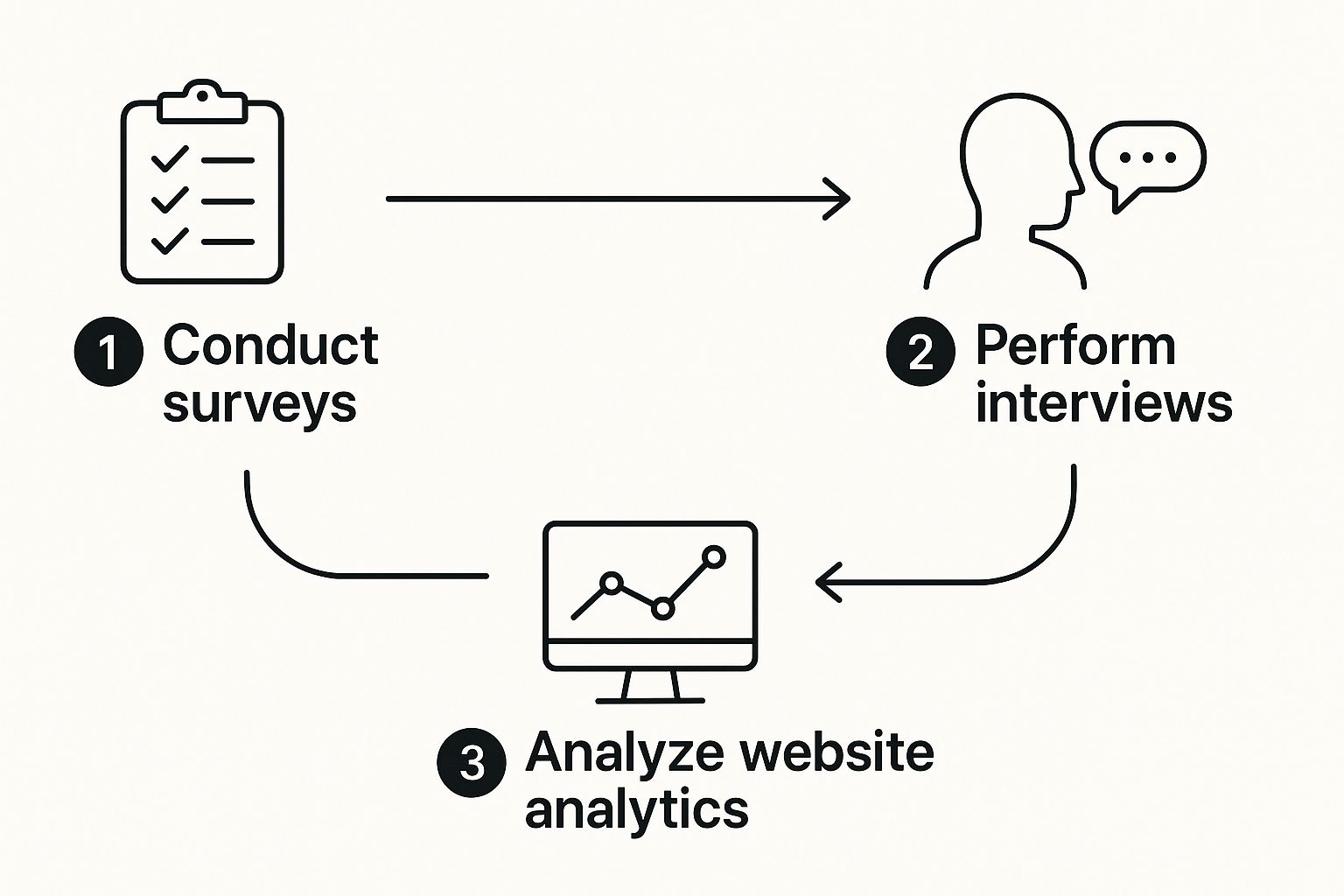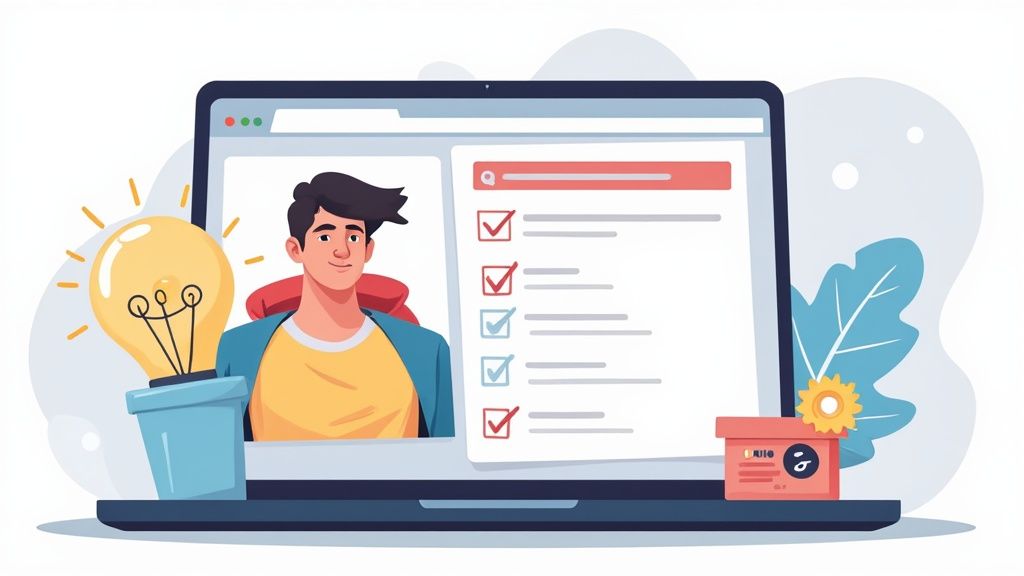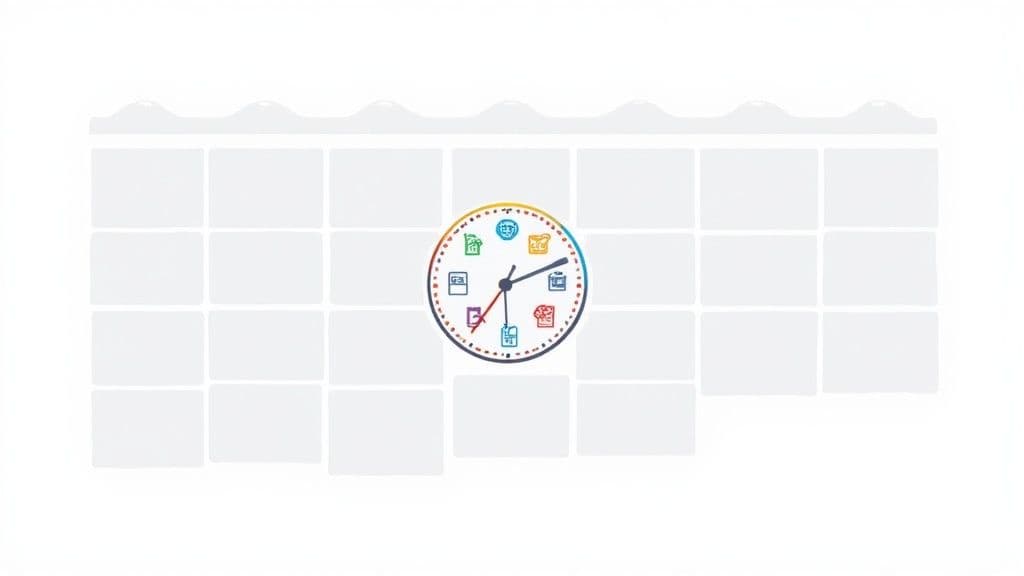So, what exactly is a buyer persona? It's about getting to know your ideal customer inside and out. You'll dig into data on their demographics, behaviors, and motivations to build a clear, semi-fictional profile that stands in for a whole segment of your audience. This whole exercise is designed to help you shape your marketing to truly connect with the people you’re trying to reach.
Why Generic Marketing Misses the Mark
Let’s be real for a second: blasting the same message to everyone just doesn’t cut it anymore. We're all drowning in content, and a one-size-fits-all approach is like shouting into a hurricane. You might make a little noise, but no one's really listening. This is exactly where creating solid buyer personas changes everything.

The best marketing always starts with the customer. It’s a strategy built on a deep, genuine understanding of who your audience is. That's the secret sauce behind every winning campaign. You stop guessing what might work and start building your entire plan around the actual problems and goals of your customers.
The Power of Specificity
Think about it this way. Imagine two different SaaS companies, both selling project management tools.
- Company A sends a generic email blast to its 10,000 subscribers, announcing "new task management features." It's okay, but a bit bland.
- Company B has done its homework. It sends a carefully crafted email to "Project Manager Pam," a persona they’ve developed. The message focuses on how the new features solve her single biggest headache: keeping different teams aligned and hitting their deadlines.
See the difference? Company B isn't just listing features; it's speaking directly to Pam's real-world struggles. This focused approach feels personal and relevant, which is why it grabs attention and brings in much better leads. Knowing your personas is also a cornerstone of any good multi-channel marketing strategy, because it keeps your message sharp and consistent, no matter where people find you.
Creating buyer personas isn't just another marketing task to check off a list. It's a foundational business strategy that gets your entire company focused on the people who matter most.
The Tangible Impact on Your Business
Switching to a persona-driven strategy pays off in real, measurable ways. For starters, customer-centric companies are 60% more profitable than companies that aren't. That’s no accident.
When you tailor your messaging to specific people, you see engagement numbers climb. For example, personalized content can lift email click-through rates by 14% and bump conversion rates by 10%. On top of that, businesses that keep their personas fresh and updated are way more likely to smash their lead and revenue goals. It’s simple, really: understanding your customer is one of the smartest investments you can make.
Finding the Right Ingredients for Your Personas
Great buyer personas aren't built on assumptions; they're built on solid research. Think of it as your foundation. A wobbly foundation leads to a wobbly strategy, but a strong one supports everything you build on top of it. This is where we get our hands dirty and gather the raw materials needed to paint a truly accurate picture of your ideal customer.
The best place to start is often right under your own roof. Most companies are sitting on a treasure trove of customer data and don't even know it. Your CRM and sales analytics are packed with clues about who your best customers are, where they came from, and what they care about.
Start With Your Internal Experts
Before you even think about external surveys, go talk to your own team. Your sales reps and customer support specialists are on the front lines every single day. They hear the unfiltered feedback, the real-world frustrations, and the moments of delight from your customers.
Pull them aside for a quick chat. You're not looking for a formal, hour-long meeting, just some genuine insight.
Ask them things like:
- What are the top three questions you always get from new prospects?
- What's the one thing that makes a potential customer hesitate?
- Which features do our happiest customers rave about?
- Are there any recurring complaints or issues our support team is constantly solving?
These conversations add color and context to the raw numbers. They give you the "why" behind the data, helping you connect with the actual human challenges your audience is up against.
Blend the "What" With the "Why"
The most effective buyer personas are never one-dimensional. They combine two distinct types of information: quantitative data (the "what") and qualitative data (the "why"). One tells you what's happening, and the other explains the human story behind it.
You need both to see the full picture.

This simple workflow is a great reminder of how different data sources work together. Surveys can give you broad, statistical insights, while direct interviews provide the deep, personal context you can't get anywhere else. Analytics then help you validate those behaviors at scale.
A critical first step here, especially for content-focused strategies, involves identifying your target audience for a B2B podcast or blog. Getting this right from the start ensures you're asking the right questions to the right group of people.
Key Takeaway: Relying on just one data source is like trying to understand a person by only looking at their shadow. You get an outline, but you miss all the important details.
To dig deeper, you need to look at a few different data collection methods. Each one offers a unique piece of the puzzle.
Data Collection Methods for Buyer Personas
The table below breaks down some common research methods, showing what they're best at uncovering and how you can put them into action.
| Method | Type | Best For Uncovering | Example Action |
|---|---|---|---|
| Customer Interviews | Qualitative | Motivations, pain points, "Aha!" moments | Schedule 30-minute calls with 5-10 of your best customers. |
| Online Surveys | Quantitative | Demographic data, preferences at scale | Use SurveyMonkey to ask 100+ prospects about their biggest industry challenge. |
| CRM/Sales Data | Quantitative | Firmographics, purchase history, deal size | Analyze your CRM to find the common job titles of your highest-value accounts. |
| Website Analytics | Quantitative | User behavior, content interests | Use Google Analytics to see which blog posts your target segment visits most. |
| Team Interviews | Qualitative | Common objections, customer feedback | Host a lunch-and-learn with your sales team to discuss recent wins and losses. |
Each of these methods contributes something valuable. The real magic happens when you start layering the insights from each one to build a complete, nuanced profile.
One of the most powerful things you can do is conduct real customer interviews. This is where you move beyond charts and spreadsheets and hear about your customer's goals and challenges in their own words.
Try to talk to a mix of people: your biggest fans, brand-new customers, and even some prospects who decided to go with a competitor. This variety is crucial for getting a balanced perspective that truly reflects your market.
Turning Raw Data into a Human Story
You’ve done the hard work. You’ve gathered the feedback, pulled the reports, and actually talked to real people. Now you're looking at a mountain of data—spreadsheets, interview transcripts, and analytics dashboards. This is where the magic happens. It's time to transform all that raw information into a human story.

This isn’t about just listing facts. It’s about finding the narrative hidden inside the numbers. You need to sift through all the feedback to spot the common themes, motivations, and frustrations that define a specific group of people. This is how abstract data points become a relatable story your entire team can get behind.
Connecting the Dots to Find Patterns
Your first job is to become a pattern-finder. Start grouping similar comments and data points together. Did a handful of interviewees mention their struggle with "team collaboration"? That's a potential pain point. Does your CRM data show that your best customers are mostly "Marketing Managers"? That’s a key demographic clue.
Let's walk through an example. Imagine you’ve gathered this data:
- CRM Data: A lot of your leads are marketing managers at SaaS companies with 50-200 employees.
- Interview Quote: One manager said, "I spend half my Monday just trying to figure out what my team accomplished last week."
- Survey Finding: 65% of respondents feel overwhelmed by managing multiple social media channels.
- Website Analytics: Your blog post on "social media reporting" is your most popular piece of content with this audience.
Individually, these are just interesting tidbits. But when you put them together, they start to paint a picture of a real person. You can almost see the outline of 'Marketing Manager Mary' emerging from the fog.
She’s busy, she's focused on team productivity, and she's actively looking for better ways to prove the ROI of her social media efforts. Improving your content performance analysis is crucial for showing this value, which is a challenge Mary probably deals with every single day.
Your goal isn't just to collect data points but to understand the relationship between them. A job title connects to a specific challenge, which then drives a search for a particular type of content.
From Observation to Objective Segments
This mix of qualitative stories and hard data is a huge leap forward for marketers. The way we create buyer personas has moved past simple observation and now includes more objective, data-driven models.
Today, many marketers use statistical techniques to segment customers, which helps cut down on bias and uncover subtle patterns in behavior and motivation. This combined approach makes sure your personas are both believable and strategically solid. You can dive deeper into the history of buyer personas to see just how much these methods have evolved.
By weaving these different threads together, you move way beyond a generic customer profile. You build a story that’s grounded in real evidence, bringing a persona like 'Marketing Manager Mary' to life and making her challenges tangible for your entire organization. This human-centric story is what makes a buyer persona such a powerful tool.
Putting a Face to the Data: Building Your Persona Profile
Alright, you've done the hard work of gathering and sorting through all that raw data. Now comes the fun part: bringing it all to life. This is where you transform those spreadsheets and interview notes into a living, breathing character your entire team can get behind.
Think of this as more than just filling in a form. You're crafting a strategic tool. The goal is to create a profile so clear and relatable that anyone on your team, from marketing to sales to product development, can instantly understand who they’re trying to reach.
It's Not Just About Demographics
Sure, knowing your ideal customer’s age and location is a starting point, but the real magic happens when you dig deeper. What's their professional life like? What keeps them up at night? What are they secretly hoping to achieve in their career? Answering these questions is how you stop talking at your audience and start connecting with them.
To get started, give your persona a name. Something memorable and maybe a little alliterative, like ‘Marketing Mary’ or ‘Startup Steve,’ works wonders. It just makes them easier to talk about in meetings.
From there, you'll want to flesh out their story with a few key pieces of information:
- Their Backstory: What’s their career been like so far? Where are they now? This context helps explain their motivations.
- A Day in Their Life: What are their actual job responsibilities? Knowing what they do all day helps you see exactly where your solution fits in.
- What They're Trying to Win: What are their primary goals? Are they trying to boost team productivity? Prove the ROI of their latest campaign?
- The Hurdles in Their Way: What are their biggest frustrations and challenges? This is gold. Your product or service should be the answer to these problems.
Pro Tip: Find a killer quote from one of your customer interviews and drop it right into the profile. Something real, like, "I'm just so tired of juggling five different tools to get one simple report," makes a persona's pain points feel immediate and undeniable. It keeps the whole thing grounded in reality.
Visualizing Your Persona
Sometimes, seeing is believing. A well-designed profile can make all the difference in helping your team visualize who you're talking about.
Here’s a great example of what a finished persona looks like when all these elements come together.
Notice how this profile for "Marketing Mary" blends the hard data with the softer, more human insights. It paints a complete picture of who she is, what she values, and how you should be talking to her.
Mapping Out Their World
To make your persona truly actionable, there are two final pieces you need to nail down: where they hang out online and what their role is in the buying process.
First, where do they get their information? Are they scrolling through LinkedIn groups, listening to industry podcasts, or reading specific blogs? Knowing this tells you exactly where you need to be to get on their radar.
Second, you need to understand their place in the buying decision. Are they the one signing the check, a key influencer who has the team's ear, or an end-user you need to win over? This is absolutely critical for tailoring your sales and marketing efforts. Get this right, and you'll know not just what to say, but who to say it to and when.
Putting Your Personas to Work Across Your Business
You've done the hard work of creating your buyer personas. That's a huge step, but don't let them gather dust in a forgotten folder. A persona isn't just a document; it's a strategic tool meant to be used every single day. Its real power comes alive when it’s woven into the very fabric of your business, guiding decisions from the top down.
When everyone—from marketing to sales to product development—shares the same, crystal-clear picture of your customer, something amazing happens. You create a truly seamless and consistent customer experience. That's the secret sauce that separates the good companies from the great ones.
Let's dig into how your different teams can put these profiles into practice.
Marketing That Truly Connects
For any marketer, a good persona is the ultimate cheat sheet for creating content that actually resonates. You can finally stop guessing what might work and start building a plan that speaks directly to your persona’s biggest challenges and aspirations.
Here’s how you can use them:
- Sharpen Your Content Calendar: If you know 'Marketing Mary' is drowning in data, a blog post titled "5 Ways to Simplify Your Social Media Analytics" is going to grab her attention immediately.
- Personalize Your Email Campaigns: Segment your email list based on your personas. 'Startup Steve' will get much more value from a case study about a similar small business than he will from a generic new feature announcement.
- Nail Your Ad Targeting: Use the demographic and psychographic details from your personas to build laser-focused audiences for your paid social and search ads. This is how you make every dollar of your ad spend count.
Sales Outreach That Gets Replies
A detailed persona can completely change a sales team's game, shifting their approach from a shotgun blast to a sniper shot. It gives them the context they need to understand a lead's world before they even pick up the phone, leading to far more meaningful conversations.
Sales reps can use personas to qualify leads more effectively and customize their outreach. For instance, if a rep knows they're about to talk to a 'CFO Frank,' they can skip the nitty-gritty technical details and focus the conversation on ROI and long-term value. This simple shift shows you've done your homework and, more importantly, that you respect their time.
A persona helps a salesperson move from "What does our product do?" to "Here is how our product solves your specific problem." It’s a subtle but powerful shift that builds trust instantly.
Product Teams Building What Matters
Finally, your product team can use personas to make much smarter development decisions. When they're staring at a long backlog of potential new features, they can ask one simple question: "Which of these would 'Marketing Mary' find most valuable?"
This keeps the entire team anchored to solving real user problems instead of getting lost building features in a vacuum. It ensures that every update and new release is grounded in a genuine customer need, which is how you create a product that people don't just use, but absolutely love.
To deliver these personalized experiences consistently, your personas are vital for effective multi-channel marketing automation strategies. They inform how and where you engage with each customer segment. You can learn more about applying these concepts by exploring our guide on marketing automation best practices.
Common Questions About Building Buyer Personas
When you first dive into creating buyer personas, it's natural for a few questions to pop up. Honestly, they come up for almost everyone. Getting these sorted out early will save you a ton of headaches and make the whole process feel less like a chore and more like a strategy.
Let's walk through some of the most common questions I hear from teams who are in the thick of it.

How Many Buyer Personas Do I Really Need?
This is always the first question, and there’s no magic number. But from experience, most businesses hit their stride with 3 to 5 key personas.
The point isn't to create a profile for every single customer variation. Instead, you want to focus on the handful of segments that truly matter—the ones who make up the bulk of your revenue or represent your biggest growth opportunities. If you try to create ten different personas right out of the gate, your efforts will be spread too thin. Start small, focus, and you can always add more later on.
Is a Buyer Persona Just a Fancy Name for a Target Market?
Nope, but I can see why people mix them up. They’re definitely related, but they serve different purposes.
A target market is broad. Think of it as a demographic bucket, like "Marketing Managers at Mid-Sized Tech Companies." It’s a useful starting point, but it's pretty impersonal.
A buyer persona brings that market to life. It’s a detailed sketch of a single, semi-fictional person who represents that group. We're talking about 'Marketing Manager Mary,' who's trying to prove her team's ROI and is overwhelmed by juggling too many platforms.
This difference is everything. A target market tells you who you're aiming for. A buyer persona tells you how to speak their language, solve their specific problems, and build a real connection.
That human element is what makes your marketing actually work.
How Often Should I Update My Personas?
Your personas are not a "set it and forget it" project. Your audience evolves, new challenges pop up, and their priorities shift. Because of that, you should plan to give your personas a good look-over at least once a year.
Also, think about revisiting them anytime your business makes a big move, like launching a new product or entering a new market. A great rule of thumb? If your messaging starts feeling a little off or isn't getting the results it used to, that's your cue. Your personas probably need a refresh.
Ready to stop guessing and start connecting with your audience on a deeper level? Postiz gives you the AI-powered insights and collaborative space you need to build powerful buyer personas and put them into action.
Discover how Postiz can transform your social media marketing.





